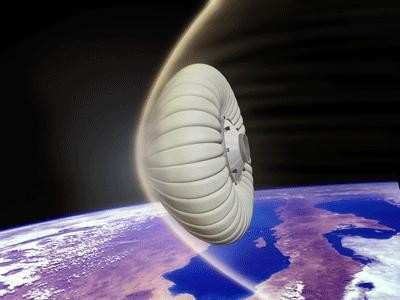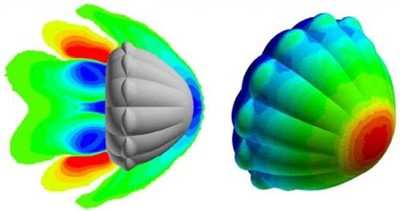NASA Awards Contract To Test Ballutes
What's that? What's a ballute? Well, it's a giant airbag is what
it is, but the word "ballute" is actually a cross between balloon
and a parachute... get it? And more importantly, NASA thinks it can
use them for the atmospheric reentry of spacecraft.

NASA's Dryden Flight Research Center awarded Andrews Space of
Seattle, WA a $600,000 Small Business Innovative Research (SBIR)
contract to continue development of its ballute systems.
Technically, the device is termed a "Flexible Transpiration Cooled
Thermal Protection System for Inflatable Atmospheric Capture &
Entry Systems." That's a lot of words... it's easier to say
ballute!
The SBIR program is one our governments brighter ideas. It
provide a means for small, high technology companies and research
institutions to participate in government-sponsored research and
development efforts in key technology areas.
Andrews Space was founded in 1999. Its staff of 60 engineers,
technicians and support personnel works with government and
commercial customers developing technologies for space
transportation systems.
So how does a ballute work? It's a pressure-stabilized,
inflatable membrane that provides a large, blunt, high-drag surface
for aero-braking systems.
Current reentry protection systems use either a material capable
of withstanding the heat and pressure, such as the shuttle's
reinforced carbon-carbon and ceramic tiles, or a layer of ablative
material designed to burn off such as that used by older Apollo
capsules and Russia's Soyuz. The criticality of these materials
cannot be overemphasized -- the shuttle Columbia broke apart on
reentry because its protective heat shield had been
compromised.
One of the drawbacks to these shielding materials is weight --
they're heavy. Ever picked up a ceramic tile? All that weight must
be carried aloft.
Ballutes offer significant advantages over rigid shells for
aerocapture and re-entry of spacecraft by providing simplified
packaging and lower total weight.
Andrews Director of Engineering Eric Wetzel says, "Ballutes
offer substantial performance advantages for planetary capture and
entry systems. We are excited to help advance the state of
the art to enable future spacecraft to include a ballute as a
design solution."
Andrews' ballute would inflate just prior to reentry with an
inert gas. Its design provides vents allowing some of the gas to
escape as it heats up and expands.

So why doesn't the material just burn up? Well for one thing,
the ballute has a much larger surface area over which to spread the
heat and pressure. Also, the gas protects the material. Have you
ever boiled water in a paper cup over an open fire? The paper won't
burn as long as there is water in the cup to absorb the heat. The
gas inside a ballute works just like the water in a paper cup; it
absorbs the heat from the friction of reentry -- ingenious!
Using a ballute to aero-brake a spacecraft isn't a new
idea -- although Andrews appears the to be the first to put the
idea into practice. The concept was featured dramatically in the
movie 2010:The Year We Made Contact, a sequel to 2001:
A Space Odyssey. A scene in the movie shows the Russian
spaceship Leonov performing a dramatic aero-brake maneuver to
attain orbit around Jupiter. The craft used a ballute for drag and
thermal protection.
The movies were based on science-fiction writer Arthur C.
Clarke's novels. Clarke is a renowned author and futurist whose
books have inspired a number of interesting ideas with real-world
applications.
 ANN FAQ: Submit a News Story!
ANN FAQ: Submit a News Story! ANN's Daily Aero-Term (05.13.25): Cleared For The Option
ANN's Daily Aero-Term (05.13.25): Cleared For The Option Aero-News: Quote of the Day (05.13.25)
Aero-News: Quote of the Day (05.13.25) Aero-News: Quote of the Day (05.14.25)
Aero-News: Quote of the Day (05.14.25) ANN's Daily Aero-Term (05.14.25): Flight Check
ANN's Daily Aero-Term (05.14.25): Flight Check




